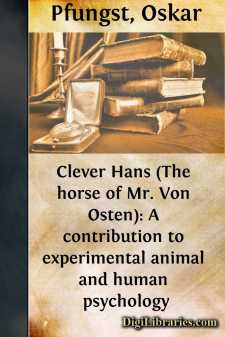Categories
- Antiques & Collectibles 13
- Architecture 36
- Art 48
- Bibles 22
- Biography & Autobiography 813
- Body, Mind & Spirit 142
- Business & Economics 28
- Children's Books 17
- Children's Fiction 14
- Computers 4
- Cooking 94
- Crafts & Hobbies 4
- Drama 346
- Education 46
- Family & Relationships 57
- Fiction 11829
- Games 19
- Gardening 17
- Health & Fitness 34
- History 1377
- House & Home 1
- Humor 147
- Juvenile Fiction 1873
- Juvenile Nonfiction 202
- Language Arts & Disciplines 88
- Law 16
- Literary Collections 686
- Literary Criticism 179
- Mathematics 13
- Medical 41
- Music 40
- Nature 179
- Non-Classifiable 1768
- Performing Arts 7
- Periodicals 1453
- Philosophy 64
- Photography 2
- Poetry 896
- Political Science 203
- Psychology 42
- Reference 154
- Religion 513
- Science 126
- Self-Help 84
- Social Science 81
- Sports & Recreation 34
- Study Aids 3
- Technology & Engineering 59
- Transportation 23
- Travel 463
- True Crime 29
Clever Hans (The horse of Mr. Von Osten): A contribution to experimental animal and human psychology
by: Oskar Pfungst
Description:
Excerpt
A horse that solves correctly problems in multiplication and division by means of tapping. Persons of unimpeachable honor, who in the master's absence have received responses, and assure us that in the process they have not made even the slightest sign. Thousands of spectators, horse-fanciers, trick-trainers of first rank, and not one of them during the course of many months' observations are able to discover any kind of regular signal.
That was the riddle. And its solution was found in the unintentional minimal movements of the horse's questioner.
Simple though it may seem, the history of the solution is nevertheless quite complex, and one of the important incidents in it is the appearance of the zoölogist and African traveler, Schillings, upon the scene, and then there is the report of the so-called Hans-Commission of September 12, 1904. And finally there is the scientific investigation, the results of which were published in my report of December 9, 1904.
After a cursory inspection during the month of February, I again called upon Mr. von Osten in July, and asked him to explain to Professor Schumann and me just what method he had used in instructing the horse. We hoped in this way to gain a clue to the mechanism of Hans's feats. The most essential parts of the information thus gleaned are summarized in . Mr. Schillings came into the courtyard for the first time about the middle of July. He came as skeptical as everyone else. But after he, himself, had received correct responses, he too became convinced, and devoted much of his time to exhibiting the horse, and daily brought new guests. To be perfectly frank, at the time this seemed to us a disturbing factor in the investigation, but now we see that his intervention was a link in the chain of events which finally led to an explanation. For it was through him that the fact was established beyond cavil, that the horse was able to respond to strangers in the master's absence. Heretofore, this had been noted only in isolated cases. Since it could not be assumed that a well-known investigator should take it upon himself to mislead the public by intentionally giving signs, the case necessarily from that time on appeared in the eyes of others in a light quite different from that in which ordinary circus-tricks would appear, to which it bore such a striking external resemblance. No matter how this state of affairs may have arisen in the course of years, no matter how it might eventually be explained,—the quality of the extraordinary would necessarily attach itself to this particular case, as it did.
Of course, to many persons in the interested public the result was merely that Schillings, also, was placed in the category of deceivers. On the other hand there were reputable scientists who could not dispose of the matter in that fashion, and these now openly took their stand with Schillings and declared that they believed in the horse's ability to think. Zoölogists especially, saw in von Osten's results evidence of the essential similarity between the human and the animal mind, which doctrine has been coming more and more into favor since the time of Darwin. Educators were disposed to be convinced, on account of the clever systematic method of instruction which had been used and which had not, till then, been applied in the education of a horse. In addition, there were many details which, it seemed, could not be explained in any other way....


